Mass point geometry
Mass point geometry, colloquially known as mass points, is a geometry problem-solving technique which applies the physical principle of the center of mass to geometry problems involving triangles and intersecting cevians.[1] All problems that can be solved using mass point geometry can also be solved using either similar triangles, vectors, or area ratios,[2] but many students prefer to use mass points. Though modern mass point geometry was developed in the 1960s by New York high school students,[3] the concept has been found to have been used as early as 1827 by August Ferdinand Möbius in his theory of homogeneous coordinates.[4]
Definitions

The theory of mass points is defined according to the following definitions:[5]
- Mass Point - A mass point is a pair , also written as , including a mass, , and an ordinary point, on a plane.
- Coincidence - We say that two points and coincide if and only if and .
- Addition - The sum of two mass points and has mass and point where is the point on such that . In other words, is the fulcrum point that perfectly balances the points and . An example of mass point addition is shown at right. Mass point addition is closed, commutative, and associative.
- Scalar Multiplication - Given a mass point and a positive real scalar , we define multiplication to be . Mass point scalar multiplication is distributive over mass point addition.
Methods
Concurrent cevians
First, a point is assigned with a mass (often a whole number, but it depends on the problem) in the way that other masses are also whole numbers. The principle of calculation is that the foot of a cevian is the addition (defined above) of the two vertices (they are the endpoints of the side where the foot lie). For each cevian, the point of concurrency is the sum of the vertex and the foot. Each length ratio may then be calculated from the masses at the points. See Problem One for an example.
Splitting masses
Splitting masses is the slightly more complicated method necessary when a problem contains transversals in addition to cevians. Any vertex that is on both sides the transversal crosses will have a split mass. A point with a split mass may be treated as a normal mass point, except that it has three masses: one used for each of the two sides it is on, and one that is the sum of the other two split masses and is used for any cevians it may have. See Problem Two for an example.
Other methods
- Routh's theorem - Many problems involving triangles with cevians will ask for areas, and mass points does not provide a method for calculating areas. However, Routh's theorem, which goes hand in hand with mass points, uses ratios of lengths to calculate the ratio of areas between a triangle and a triangle formed by three cevians.
- Special cevians - When given cevians with special properties, like an angle bisector or an altitude, other theorems may be used alongside mass point geometry that determine length ratios. One very common theorem used likewise is the angle bisector theorem.
- Stewart's theorem - When asked not for the ratios of lengths but for the actual lengths themselves, Stewart's theorem may be used to determine the length of the entire segment, and then mass points may be used to determine the ratios and therefore the necessary lengths of parts of segments.
- Higher dimensions - The methods involved in mass point geometry are not limited to two dimensions; the same methods may be used in problems involving tetrahedra, or even higher-dimensional shapes, though it is rare that a problem involving four or more dimensions will require use of mass points.
Examples
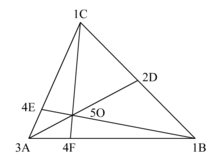
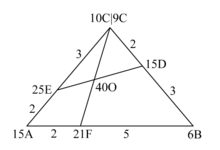
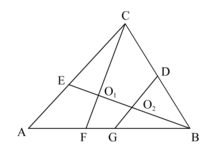
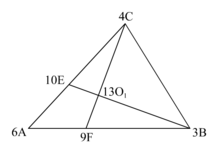
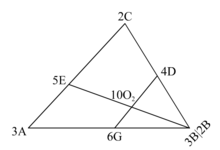
Problem One
Problem. In triangle , is on so that and is on so that . If and intersect at and line intersects at , compute and .
Solution. We may arbitrarily assign the mass of point to be . By ratios of lengths, the masses at and must both be . By summing masses, the masses at and are both . Furthermore, the mass at is , making the mass at have to be Therefore and . See diagram at right.
Problem Two
Problem. In triangle , , , and are on , , and , respectively, so that , , and . If and intersect at , compute and .
Solution. As this problem involves a transversal, we must use split masses on point . We may arbitrarily assign the mass of point to be . By ratios of lengths, the mass at must be and the mass at is split towards and towards . By summing masses, we get the masses at , , and to be , , and , respectively. Therefore and .
Problem Three
Problem. In triangle , points and are on sides and , respectively, and points and are on side with between and . intersects at point and intersects at point . If , , and , compute .
Solution. This problem involves two central intersection points, and , so we must use multiple systems.
- System One. For the first system, we will choose as our central point, and we may therefore ignore segment and points , , and . We may arbitrarily assign the mass at to be , and by ratios of lengths the masses at and are and , respectively. By summing masses, we get the masses at , , and to be 10, 9, and 13, respectively. Therefore, and .
- System Two. For the second system, we will choose as our central point, and we may therefore ignore segment and points and . As this system involves a transversal, we must use split masses on point . We may arbitrarily assign the mass at to be , and by ratios of lengths, the mass at is and the mass at is split towards and 2 towards . By summing masses, we get the masses at , , and to be 4, 6, and 10, respectively. Therefore, and .
- Original System. We now know all the ratios necessary to put together the ratio we are asked for. The final answer may be found as follows:
See also
- Cevian
- Ceva's theorem
- Menelaus's theorem
- Stewart's theorem
- Angle bisector theorem
- Routh's theorem
- Barycentric coordinates
- Lever
Notes
| Wikimedia Commons has media related to Mass point geometry. |
- Rhoad, R., Milauskas, G., and Whipple, R. Geometry for Enjoyment and Challenge. McDougal, Littell & Company, 1991.
- "Archived copy". Archived from the original on 2010-07-20. Retrieved 2009-06-13.CS1 maint: archived copy as title (link)
- Rhoad, R., Milauskas, G., and Whipple, R. Geometry for Enjoyment and Challenge. McDougal, Littell & Company, 1991
- D. Pedoe Notes on the History of Geometrical Ideas I: Homogeneous Coordinates. Math Magazine (1975), 215-217.
- H. S. M. Coxeter, Introduction to Geometry, pp. 216-221, John Wiley & Sons, Inc. 1969